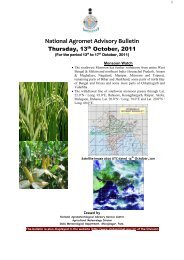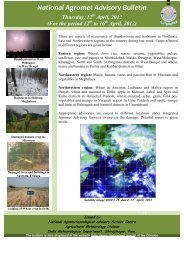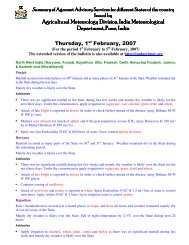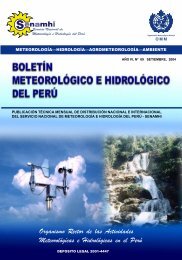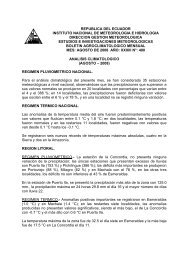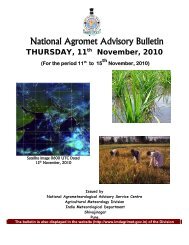Vol 15 No. 15 - Belg Seasonal Review - The World ...
Vol 15 No. 15 - Belg Seasonal Review - The World ...
Vol 15 No. 15 - Belg Seasonal Review - The World ...
Create successful ePaper yourself
Turn your PDF publications into a flip-book with our unique Google optimized e-Paper software.
FORE WARDThis Agro met Bulletin is prepared and disseminated by the National MeteorologicalServices Agency (NMSA). <strong>The</strong> aim is to provide those sectors of the communityinvolved in Agriculture and related disciplines with the current weather situation inrelation to known agricultural practices.<strong>The</strong> information contained in the bulletin, if judiciously utilized, are believed to assistplanners, decision makers and the farmers at large, through an appropriate media, inminimizing risks, increase efficiency, maximize yield. On the other hand, it is vital tool inmonitoring crop/ weather conditions during the growing seasons, to be able to make morerealistic assessment of the annual crop production before harvest.<strong>The</strong> Agency disseminates ten daily, monthly and seasonal weather reports in which allthe necessary current information’s relevant to agriculture are compiled.We are of the opinion that careful and continuous use of this bulletin can benefit to raiseones agro climate consciousness for improving agriculture-oriented practices.Meanwhile, your comments and constructive suggestions are highly appreciated to makethe objective of this bulletin a success.General ManagerNMSAP.O.Box 1090Tel: 51-22-99Fax: 51-70-66E-mail: nmsa@telecom.net.etAddis Ababa1
BELG 2005SUMMARY<strong>No</strong>rmally central parts of northern high lands, eastern highlands, parts of central,southwestern and southern Ethiopia are known as <strong>Belg</strong> growing areas. <strong>The</strong> contributionof <strong>Belg</strong> rainfall is ranging from 5-30% over the north, northeastern and eastern highlandswhere as 30-60% over south and southwestern parts of the country from annual total cropproduction of the areas. <strong>No</strong>rth Shewa, East and west Harargie, Arsi, Bale, <strong>No</strong>rth andSouth Wello, Borena and SNNPR (Kembata, Hadiya, Wolayta, Gurage, Keffa andBench) start their land preparation and sowing activities during December to February. Itis the time for water harvesting over pastoral and agro pastoral areas of southern andsoutheastern Ethiopia.During the month of February 2005, most parts of the country exhibited dry to very drymoisture status and the prolonged dry spell observed over South Tigray and parts ofeastern Amhara throughout the preceding month continued up to the third dekad ofFebruary 2005. Under normal circumstance, sowing of cereals, pulses and oil crops likeflax is a normal practice over some areas of central, northern, south western and easternhighlands at this time of the year. <strong>The</strong> persisted dry spell over South Tigray and parts ofeastern Amhara could affect early <strong>Belg</strong> season's agricultural activities like landpreparation and sowing activities. As indicated in A Joint Government and HumanitarianPartner’s Appeal (JGHP)( May 4, 2005) an unfavourable Meher season(2004) togetherwith the deficient rainfall observed during the month of January(2005) followed by acomplete failure of rains in February has resulted in serious food and water shortages incentral, southern and eastern Tigray. Moreover, the deficient fall has delayed sowingactivity over <strong>Belg</strong> growing areas of eastern Amhara, central and eastern Oromiyaincluding Harari. With regard to temperature anomalies a rise in dekadal mean maximumtemperatures by 3.2- 5.6°C has been observed over some lowland areas of northeastern,northwestern, eastern, central and southeastern parts of Ethiopia as compared to that oflong term dekadal mean maximum temperature during the third dekad of February2005. Thus, this condition exacerbates the negative effect of deficient moisture on cropsby increasing the rate of evapotranspiration.During the month of March 2005 with the exception of South Tigray and northern partsof eastern Amhara most parts of <strong>Belg</strong> rain benefiting areas experienced moist to humidmoisture status. <strong>No</strong>rmally land preparation is the normal practice over some areas ofcentral and southern Oromiya. Sowing of cereals like maize, sorghum and others,including pulses is the major activities over most parts of SNNPR, eastern and mid landsof southern Oromiya and some areas of eastern Amhara. Major "Gu" rains expected tostart over northern region of Somali in March. Due to the improvement in moisture statusparticularly during the first and second dekad of March 2005, sowing of long cycle cropslike maize and sorghum was underway in most places. <strong>The</strong> wet condition also favoured<strong>Belg</strong> crops that were sown earlier in some highland areas of eastern Amhara like Guguftuand Tebasit. <strong>The</strong> abundant falls observed over the lowlands of southern Oromiya,SNNPR and mid lands of Somali have helped to alleviate the severe prolonged watershortage to some extent. Nevertheless, because of the persisted deficient rainfall during2
the third dekad of March in most parts of the country, crops suffered from water stress insome <strong>Belg</strong> growing areas of central and north eastern highlands. With regard totemperature anomalies, there was a slight increase in mean dekadal maximumtemperature in some areas of northeastern and southeastern lowlands like Gode, andDubti by 1.4 and 2.9°C, respectively.During the month of April 2005, the over all moisture situations particularly observedduring the second and third dekad of the month has paramount importance for season'sagricultural activities and land preparation for the coming Kiremt season. <strong>No</strong>rmally it istime for sowing of long cycle crops like maize and sorghum including pulse crops likeharicot bean over most parts of crop growing areas. Moreover, it is also time to harvestwater for pasture and drinking water over the lowlands of southern and south-easternpastoral and agro pastoral areas. During April 2005 moist to humid moisture status hasbeen observed in most parts of long cycle crop growing areas. On the other hand longcycle crop growing areas of western parts of Gambela, parts of western and few areas ofeastern Oromiya, western and southeastern Amhara exhibited moderately dry to drymoisture condition. <strong>The</strong> dry situation during the first dekad of April 2005 over most partsof the country could exacerbate the moisture stress of <strong>Belg</strong> crops observed during thepreceding dekad (March 21-31, 2005). Besides, it has negative impact on the normalsowing activities of long cycle crops in areas where sowing activities were underquestion like Arsi Robe, Kulumsa, Ziway, Kibre Mengist, Robe, Limu Genet, Aman,Tepi, Sekoru, Wenago, Yirga Chefe, Kochere, Bule and Sirinka. Pursuant to the cropphenological report some areas of northern SNNPR (Hosaina), western Oromiya (Alge)and eastern Amhara (Majete) reported medium field condition due to water stress duringthe first dekad of April 2005. <strong>The</strong> rainfall condition particularly during the second andthird dekad of April have helped to lighten the severe long-existing water shortage inpastoral areas like Afder, Liben, Gode, Dege Bur and Jijiga. However, the availability ofpasture and drinking water has not yet fully improved in some areas of Afar and Somali(JGHP Appeal May 4, 2005). Besides the regeneration of pasture is poor in most parts ofpastoral areas of Afar and Somali but the situation favoured the browsers rather.Generally tthough the persisted deficient condition was observed during the third dekadof March followed by first dekad of April the over all moisture situation particularlyobserved during the second and third dekad of April has paramount importance forseason's agricultural activities (sowing of long cycle crops) and land preparation for thecoming Kiremt season.During the month of May 2005, moist to humid moisture status has been observed overmost parts of <strong>Belg</strong> and Meher growing areas while dry to moderately dry moisture statushas been observed over Meher growing areas of western Amhra and Tigray. <strong>The</strong> cropscondition were in a good shape over most parts of <strong>Belg</strong> growing and Meher growingareas as well due to the observed normal to above normal rainfall during the month ofMay. Nevertheless, some areas of central and southern Ethiopia exhibited heavy fallsduring the month repeatedly. Thus, some areas like Kibre Mengist, Hagere Mariam, Aira,Sodo and Burji reported crop damage and livestock losses due to heavy fall. On thecontrary, the observed deficient falls over most parts of western half of the countryresulted in wilting on recently sown cereal crops like maize and sorghum in some areas3
(Debre Markos and Ghimbi) during the second dekad of May 2005. As the NDVI picture(USGS) indicates, there was an improvement of vegetation cover dekad by dekad overeastern highlands, southern and southeastern lowlands during the month of May 2005.With regard to adverse Weather conditions, Sodo reported bad and medium fieldcondition due to severe and slight water logging on maize and peas crop fields caused byheavy falls. Aira reported maize crop damage due to heavy fall with strong wind. On thecontrary, Debre Markos and Ziway reported medium field condition due to water stressduring the third dekad of May.Generally, though the cumulative percent of normal <strong>Belg</strong> rainfall amount is normal toabove normal over most parts of <strong>Belg</strong> growing areas the erratic rainfall distribution overSouth Tigray and some low land areas of eastern Amhara resulted in poor performance of<strong>Belg</strong> crop production over the areas. <strong>The</strong> rainfall condition observed as of the seconddekad of April has favoured <strong>Belg</strong> crops as well as sowing of long cycle crops overcentral, western, eastern and southern parts of the country. It has significant contributionfor pastoral and agro pastoral areas of southern low lands for the availability of pastureand drinking water. Besides, it could favour sowing activities of “Gena” season’s cropslike maize, haricot bean, teff, sorghum and wheat. On the other hand, heavy fallsobserved during the third dekad of April, first and second dekad of May 2005 (31.5-90.3mm of rainfall in one rainy day) over pocket areas of north-eastern, central, eastern andsouthern parts of the country resulted in crop damage and livestock losses. Moreover theheavy falls causing over flow of rivers and resulted in crop damage and livestock lossesover the lowlands of pastoral areas like Gode, West and East Imi, Kelafo and Mustahil.<strong>The</strong> observed rise in mean maximum temperature particularly during the third dekad ofFebruary (by 3.2-5.6°C) and first dekad of April (by 1.8-4.1°C) over some lowland areasof northeastern, northwestern, western eastern, central, southwestern and southeasternparts of the country as well as along the Rift valley and its adjoining areas couldexacerbates the negative effect of deficient moisture on crops by increasing the rate ofevapotranspiration.4
Figure 1. <strong>Belg</strong> growing areas of Ethiopia(Darkgreen hatched areas)Figure 2. Moisture Status for January 2005Figure 3 Moisture Status for February 2005Figure 4 Moisture Status for March 2005Figure 5 Moisture Status for April 2005Figure 6 Moisture Status for May 20055
Fig. 7 Rainfall distribution in mm (21- 31 May 2005)1. WEATHER ASSESSMENT1.1 May 21-31, 20051.1.1 Rainfall Amount (Fig7)Part of Southern Oromia, pocket areas of Southwestern Somali, SouthernBenishngul Gumuz and Western Oromia received greater than 100mm of rainfall.Much of SNNPR, Western and Southern Oromia, Southern half of BenishngulGumuz, part of Southwestern Somali received 50 – 100mm of rainfall. Much ofTigray, <strong>No</strong>rthern and Eastern Amhara, Eastern and pocket areas of CentralOromia, Southwestern Oromia received 25 – 50mm of rainfall. <strong>No</strong>rthern Afar,South and eastern margin of Amhara, most part of central Oromia and Southernand eastern Somali received 5 – 25mm of rainfall. While the rest portion of thecountry received little or no rainfall.6
Fig. 8 Percent of normal rainfall (21-31 May 2005)Explanatory notes for the legend: 125% ---- Above normal1.1.2 Rainfall Anomaly (Fig. 8)Gambela, most parts of Tigray and SNNPR, parts of central and eastern Amhara,western, eastern and southern Oromiya, most parts of northern half of Afar,southern and southeastern Somalia and South Western Benshangul Gumuzexperienced normal to above normal rainfall, while the rest part of the countryreceived below normal rainfall.7
Fig. 9 Rainfall distribution in mm for the month of May 20051.2 May 20051.2.1 Rainfall Amount (Fig. 9)Pocket areas of southern Oromia received greater than 400 mm of rainfall. Part ofsouthern Oromia, pocket area of northern SNNPR received 300 – 400 mm ofrainfall. Gambela, most part of Oromia and SNNPR, parts of southwestern Somaliand southern Benishngul Gumuz received 100 – 300 mm of rainfall, while the restpart of the country received less than 100 mm of rainfall.8
Fig. 10 Percent of normal rainfall for the month of May 2005Explanatory notes for legend< 50 -- Much below normal50 –75% --- Below normal75 – 125% --- <strong>No</strong>rmal> 125% ---- Above normal1.2.2 Rainfall Anomaly (Fig.10)Most parts of Tigray, much of Oromia and SNNPR, Amhara and BenishngulGumuz, most parts of western half of Afar and part of southwestern Somaliexperienced normal to above normal rainfall. While the rest portions of thecountry were below normal rainfall.9
Fig. 11 Rainfall distribution in mm for <strong>Belg</strong> 20051.3 <strong>Belg</strong> 20051.3.1 Rainfall Amount (Fig. 11)Debre Markos, Kibre Mengist, Sodo, Jinka, Hagere Mariam, Arbaminch, Konso,Negelle, Hossaina, Gelemso, Jinka, Masha, Bui and Chira recorded 739.2, 737.2,698.6, 602.0, 588.4, 568.2, 554.4, 530.3, 505.3, 471.0, 457.4, 434.3, 424.3 and404.5 mm of seasonal rainfall respectively. With the exception of western half ofTigray, north and northwestern Amhara, parts of northern, most parts of northernhalf of Afar, southern and eastern Somali most part of the country exhibitedgreater than 100mm of seasonal rainfall.10
Fig. 12 Percent of <strong>No</strong>rmal rainfall for <strong>Belg</strong> season, 2005Legend125% -- Above normal1.3.2 Rainfall Anomaly (Fig. 12)SNNPR, most part of Amhara, most parts Tigray and Oromai, part of <strong>No</strong>rthernSomali, Southern and Western margin of Afar and southeastern Gambella exhibitednormal to above normal rainfall while the rest part of the country exhibited belownormal rainfall.1.4 TEMPERATURE ANOMALYA rise in mean maximum temperature particularly during the third dekad of February(by 3.2-5.6°C) and first dekad of April (by 1.8-4.1°C) over some lowland areas ofnortheastern, northwestern, western eastern, central, southwestern and southeasternparts of the country as well as along the Rift valley and its adjoining areas during theseason under review.11
2. WEATHER OUTLOOK2.1 For the month of June 2005For the coming month of June, normal to above normal rain is anticipated overGambela, western and central Oromya, SNNPR, and Benshangu-Gummuze, as wellas western parts of Amhara and Tigray. Besides, eastern Tigray, eastern Amhara aswell as eastern and southern Oromiya and the adjoining areas of eastern part of SNNPare mostly expected to have close to normal Rainfall. However, some places willhave a chance of getting below normal rain. On the other hand, Afar and its adjoiningareas however will be dominated by dry weather condition. Few places will haveisolated rain showers.2.3 For the Kiremt season, 2005<strong>The</strong> seasonal rain is expected to start within the normal onset periods. <strong>The</strong>re areenhanced probabilities of getting better rainfall activities in July and August. Heavyrains are likely to occur frequently over the highlands. <strong>The</strong>se phenomena areanticipated to induce flood catastrophes preferably along the riverbanks and low-lyingareas of the country. <strong>The</strong> seasonal rains are predicted to perform better over westernhalf than eastern sectors of the country. In addition to the natural rainfall variability,below normal rains are predicted at pocket areas of northeast, east and southernhighlands and the Rift Valley regions. Dry weather conditions are expected todominate south and southeast Ethiopia throughout the season. <strong>The</strong> season rain willretreat west as well as southward within the normal cessation period.3. AGROMETEOROLOGICAL CONDITIONS AND IMPACT ON AGRICULTURE3.1 VEGETATION CONDITION AND IMPACT ON AGRICULTUREGenerally, the erratic rainfall distribution over South Tigray and some low land areas ofeastern Amhara resulted in poor performance of <strong>Belg</strong> crop production over the areas. <strong>The</strong>rainfall condition observed during the first and second dekad of March favored <strong>Belg</strong>crops particularly over the highlands of eastern Amhara, eastern and midlands ofsouthern Oromiya and most parts of SNNPR. Besides, it could favour land preparation inagro pastoral areas of southern Oromiya like Yabello, Mega and Moyale. <strong>The</strong> deficientfalls persisted during the third dekad of March and first dekad of April negativelyaffected the normal growth and development of the crops in most parts of <strong>Belg</strong> cropsdependent areas. <strong>The</strong> rainfall condition observed as of the second dekad of April hasfavoured <strong>Belg</strong> crops as well as sowing of long cycle crops over central, western, easternand southern parts of the country. It has significant contribution for pastoral and agropastoral areas of southern low lands for the availability of pasture and drinking water.Besides, it could favour sowing activities of “Gena” season’s crops like maize, haricotbean, teff, sorghum and wheat. On the other hand, heavy falls observed during the third12
dekad of April, first and second dekad of May 2005 (31.5-90.3 mm of rainfall in onerainy day) over pocket areas of northeastern, central, eastern and southern parts of thecountry resulted in crop damage. Moreover the heavy falls causing over flow of riversand resulted in crop damage and livestock losses over the lowlands of pastoral areas likeGode, West and East Imi, Kelafo and Mustahil. <strong>The</strong> wet weather condition observedduring the month of May 2005 could favour <strong>Belg</strong> crops, which were sown, delayed bytwo to three weeks in some areas of northeastern and eastern highlands. Even though theerratic rainfall situation, which is one of the conducive factors for the outbreak of pests,observed over some areas of northeaster, southern, southeastern and eastern, mid landand lowlands of Ethiopia, there was no serious pest outbreak beyond the normalcircumstance. <strong>The</strong> observed rise in mean maximum temperature particularly during thethird dekad of February (by 3.2-5.6°C) and first dekad of April (by 1.8-4.1°C) over somelowland areas of northeastern, northwestern, western eastern, central, southwestern andsoutheastern parts of the country as well as along the Rift valley and its adjoining areascould exacerbates the negative effect of deficient moisture on crops by increasing the rateof evapotranspiration.Pursuant the crop phenological report (21-31 May, 2005) sowing of maize was under wayover some areas of western and northwestern parts of the country like Chagni and LimuGenet. It was at early vegetative stage over some areas of western and north-westernparts of the country like Nedjo, Sekoru, Debre Markos and Assosa while at tasseling andflowering stages over some areas of eastern and western Oromiya (Gelemso, Bedelle andDembi Dolo) and north-eastern SNNPR including some areas of midlands of Oromiya(Dolo Mena), western Oromiya (Chira) and north-western Benishangul-Gumuz(Mankush). Sowing of Sorghum was under way during the third dekad of May in someareas of eastern Amhara like Bati. It was at emergence stage in western Oromiya likeNedjo, Dembi Dolo and Assosa while at early vegetative stage in some areas of westernOromiya like Alge, Gimbi and Chira. Sowing of millet was under way during the thirddekad of May in some areas of western Oromiya. Pulse crops were at flowering stage insome areas of northeastern SNNPR. Harvesting of teff was under way in some areas ofsouth-eastern Amhara like Majete.3.2 EXPECTED WEATHER IMPACTS ON AGRICULTURE DURING THECOMING KIREMT SEASONUnder normal circumstance most parts of the highlands including southern and easternmidlands known as Kiremt growing areas. <strong>The</strong> <strong>Belg</strong> season rainfall particularly therainfall amount and distribution during the months of April and May has significantimpact on the performance of long cycle crops like maize and sorghum that areconsidered as Meher crops. <strong>The</strong>ir contribution is about 35% of the total Meherproduction. <strong>The</strong> crops are mainly cereal crops like sorghum, maize, teff, millet, barleyand wheat including pulse crops like beans, peas, lentil and chickpeas, vegetable cropslike onion, potato and oil crops like nug, flax and sesame.Main rainy season (Karma –13
July/August-September/October) for Afar. Little or no rain is the normal phenomenon ofthe season for southern and southeastern lowlands.<strong>The</strong> anticipated 75-80% probability of normal to above normal rainfall distribution overmost parts of northeastern, eastern, southern highlands and parts of central Ethiopiawould favor season’s agricultural activities. <strong>The</strong> normal on-set would be favorable forland preparation and sowing of cereals and pulses where the activities are under questionduring the month of June like central (Abomsa, Kulumsa, Meraro, Ziway, Bui, Woliso,Ambo, Kachise, Debre Birhan), northern and northwestern (Benishangul Gumuz, someareas of western Oromiya) and north and northeastern highlands (Adwa, Fiche, Enewary,Alem Ketema, Debre Birhan, Sola Gebeya, Mehal Meda, Chefa, Amba Mariam,Laibela,..). <strong>The</strong> June rainfall would also favour the existing <strong>Belg</strong> crops that are notattaining maturity and the recently sown long cycle crops. Nevertheless, the expected 20-25% probability of below normal rainfall condition would affect the water requirementsof the crops particularly over the lowland areas, which are classified under drought proneareas. Thus, proper water harvesting techniques would be advisable over those areas.<strong>The</strong> anticipated better rainfall during the months of July and August would createfavourable situation for the availability of pasture and drinking water over northeasternlowlands. Thus, attention should give for proper water harvesting techniques in order toavoid unnecessary water losses. <strong>The</strong> expected below normal rainfall (erratic) conditionover pocket areas of eastern half of Kiremt benefiting areas including pocket areas ofsouthern highlands and Rift Valley Region would favour the occurrence of pests. Thus,attention should be given for those areas in order to mitigate the effect of adversesituation below economic threshold level. <strong>The</strong> anticipated heavy falls over some areas ofwestern and central Ethiopia would result in water logging and flooding in low-lyingareas and in areas where the soil type is clay. Besides it would result in flood near theriver Banks. Thus, proper attention should be given over sensitive areas. <strong>The</strong> anticipatedabundant falls over some areas of western and central Ethiopia would enhance weedinfestation. Hence, proper cultural practices should be applied according to the existingrealty of the specific areas judiciously. <strong>The</strong> normal cessation of Kiremt rain would favourharvest and post harvest activities. Finally yet importantly, the onset, distribution andcessation of season’s rainfall are very important in terms of agricultural activities. Thus,users should interpret the weather forecast in terms of their area of interest and theexisting condition of the specific area.14
Table 1 Climatic and Agro-Climatic elements of different stations for the monthof May 2005A/Stations Region rainfall <strong>No</strong>rmal %of <strong>No</strong>rmal ETo mm/day Monthly ETo Moisturestatus1 Adigrat TIGRAI 34.7 49.5 70.1 4.43 137.33 MD2 Adwa 38.7 38.1 101.6 5.21 161.51 D3 Mekele 55.3 31.6 175.0 5.81 180.11 MD4 Michew 97 73.2 132.5 4.07 126.17 M5 Senkata 11.6 53.9 21.5 NA NA NA6 Shire 53.1 30.2 175.8 6.07 188.17 MD1 Dubti AFAR 10.7 11.7 91.5 6.68 207.08 VD2 Assayta 0 8.5 0.0 NA NA NA1 Bahirdar AMHARA 74.6 82.2 90.8 5 <strong>15</strong>5 MD2 Bati 709 62.9 1127.2 4.51 139.81 H3 Bullen 63.6 167.7 37.9 4.62 143.22 MD4 Chagni 184.9 146.3 126.4 5 <strong>15</strong>5 H5 Chefa 95.9 21 456.7 4.95 <strong>15</strong>3.45 M6 Combolcha 89.8 65.1 137.9 4.27 132.37 M7 D.Birhan 86 46.2 186.1 3.58 110.98 M8 D.Markos 43 59.3 72.5 4.6 142.6 MD9 D.Tabor 56.3 92.8 60.7 NA NA NA10 Enwary 76.7 51.6 148.6 4.56 141.36 M11 Gonder 17.4 92.7 18.8 5.35 165.85 D12 Lalibela 65 39.6 164.1 4.4 136.4 MD13 M.Meda 98.6 392 25.2 NA NA NA14 Majete 82.9 85.2 97.3 4.63 143.53 M<strong>15</strong> Metema 62.9 65.7 95.7 6.64 205.84 MD16 Mota 20.3 81.5 NA NA NA NA17 S.Gebeya 86.8 50.7 171.2 3.54 109.74 M18 Sirinka 88.1 82.6 106.7 4.27 132.37 M19 Woreilu 84.6 32.6 259.5 4.58 141.98 M20 Wegeltena 83.4 39.9 209.0 3.9 120.9 M1 Alge OROMIYA 78.5 223.2 35.2 NA NA NA2 Aira 186.2 90.6 205.5 4.06 125.86 H3 Alemaya 198.3 109.7 180.8 3.81 118.11 H4 Bedelle <strong>15</strong>5.5 226.1 68.8 3.42 106.02 H5 Begi 138.1 230 60.0 NA NA NA6 Bui 141.9 256.9 55.2 4.27 132.37 H7 D.Dolo 135 208.9 64.6 3.65 113.<strong>15</strong> H8 D.Mena 431.3 127.5 338.3 3.55 110.05 H9 D.Zeit 87.3 52.9 165.0 4.55 141.05 M10 Fitche 82.1 58.7 139.9 4.03 124.93 M11 Gelemso 230.3 129.7 177.6 3.67 113.77 H12 Gimbi 176.5 195.1 90.5 4.72 146.32 H<strong>15</strong>
13 H.Mariyam 429.9 207.5 207.2 NA NA NA14 Jimma 179.2 162.3 110.4 3.31 102.61 H<strong>15</strong> K.Mengist 375.9 237.2 <strong>15</strong>8.5 3.03 93.93 H16 Kachise 127.3 86.3 147.5 NA NA NA17 Kulumsa 69.6 85.5 81.4 3.49 108.19 M18 Masha 148.6 251.9 59.0 3.04 94.24 H19 Meisso 97 61.3 <strong>15</strong>8.2 4.66 144.46 M20 Metehara 83.8 29.5 284.1 5.2 161.2 M21 Nazreth 77.6 56.4 137.6 4.8 148.8 M22 Neghele 339.7 163.1 208.3 3.57 110.67 H23 Nedjo <strong>15</strong>3.9 192.9 79.8 3.95 122.45 H24 Nekemte 185.2 217.4 85.2 4.02 124.62 H25 Robe(Bale) 135.8 80.8 168.1 3.42 106.02 H26 Sekoru 229.3 168.9 135.8 3.65 113.<strong>15</strong> H27 Shambu 102.4 189.6 54.0 4.39 136.09 M28 Yabello 95.1 109.4 86.9 NA NA NA29 Zeway 197 81.5 241.7 4.34 134.54 H1 D.habur SOMALI 24.3 90.4 26.9 NA NA NA2 Gode 32.1 58.3 55.1 5.81 180.11 D3 Jijiga 52.7 98.8 53.3 4.41 136.71 MD1 A.Minch SNNPR 243.1 136.7 177.8 3.73 1<strong>15</strong>.63 H2 Awassa 144.7 121.6 119.0 3.48 107.88 H3 Hosaina 201.6 134 <strong>15</strong>0.4 3.39 105.09 H4 Jinka 145.7 165.2 88.2 3.18 98.58 H5 Konso 259 45.9 564.3 NA NA NA6 M.Abay 234.2 105.8 221.4 NA NA NA7 Sodo 323.2 181.3 178.3 3.39 105.09 H1 Pawe B/GUMUZ 27.3 116.6 23.4 NA NA NA2 Assossa 100.7 118.5 85.0 5.17 160.27 M1 A.A.Obs. A.A 146.8 77.4 189.7 NA NA NA1 Diredawa D.D 28.3 45.9 61.7 5.1 <strong>15</strong>8.1 D1 Harar Harai <strong>15</strong>4.4 123.7 124.8 3.35 103.85 HLegendVD Very Dry < 0.1D Dry 0.1 - 0.25MD Moderatly Dry 0.25 - 0.5M Moist 0.5 - 1H Humid >1Explanatory <strong>No</strong>teETo Reference Evapotranspiration(mm)16
DEFNITION OF TERMSABOVE NORMAL RAINFALL:BELOW NORMAL RAINFALL:- Rainfall in excess of 125% of the long term mean- Rainfall below 75 % of the long term mean.NORMAL RAINFALL: - Rainfall amount between 75 % and 125 % of the long termmean.BEGA: - It is characterized with sunny and dry weather situation with occasional falls. Itextends from October to January. On the other hand, it is a small rainy season for thesouthern and southeastern lowlands under normal condition. During the season, morningand night times are colder and daytime is warmer.BELG: - Small Rainy season that extends from February to May and cover s southern,central, eastern and northeastern parts of the country.CROP WATER REQUIREMENTS: - <strong>The</strong> amount of water needed to meet the waterloss through evapotransipiration of a disease free crop, growing under non-restricting soilconditions including soil water and fertility.DEKAD: - First or second ten days or the remaining days of a month.EXTREME TEMPERATURE: - <strong>The</strong> highest or the lowest temperature among therecorded maximum or minimum temperatures respectively.ITCZ: - Intertropical convergence zone (narrow zone where trade winds of the twohemispheres meet.KIREMT: - Main rainy season that extends from June to September for most parts ofthe country with the exception of the southeastern lowlands of the country.RAINY DAY: - A day with 1 or more mm of rainfall amount.17
18StationCODEA. Robe ARA.A. BoleAAAdigratAGAdwaADAiraAIAlemayaALAlem KetemaALKAlgeALGAmboAMBArbaminchAMAsaitaASAselaASLAssosaASOAwassaAWAykelAKB. Dar BDBatiBABedelleBDLBUIBUCombolchaCBD.BerehanDBD.HabourDHD.MarkosDMD.ZeitDZD/DawaDDD/MenaDOMD/OdoDOD/TaborDTDanglaDGDillaDLDm.DoloDMDDubtiDBTEjajiEJEnwaryENFicheFCFiltuFLGambelaGMGelemsoGLGinirGNGodeGDGonderGDRGoreGRH/MariamHMHarerHRHolletaHLHossainaHSHumeraHUJijigaJJJimmaJMJinkaJNK.DeharKDK/MingistKMKachiseKAKoffeleKFKonsoKNKulumsaKLLalibelaLLM.MedaMMM/AbayaMABMaichewMYMajeteMJMashaMAMekeleMKMerraroMRMeteharaMTMetemaMTMMiesoMSMoyaleMLM/SelamMSLNazerethNTNedjoNJNegelleNGNekemteNKPawePWRobeRBSawlaSWSekoruSKSenkataSNShambuSHShireSHRShola GebeyaSGSirinkaSRSodoSDWegel TenaWTWolisoWLWoreiluWIYabelloYBZiwayZW




